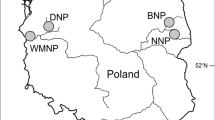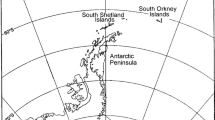Abstract
Food habits of the American mink Mustela vison were studied based on the analysis of 2364 scat samples, collected at three lakes in Northeastern Poland. The mink preyed on a wide range of prey, but two types of prey, amphibians and fish, dominated in the diet of the mink during all the seasons. Frogs, and first and foremost, the common frog Rana temporaria, were hunted by the mink, mainly from the late autumn until the early spring, and comprised up to 83.9% of the prey biomass (the multiannual average for November–December at the Majcz Wielki Lake). The most frequently eaten fish were cyprinids and percids. Seasonality of fish consumption by mink was not as well pronounced as in the case of amphibians. At the first two lakes, fish were hunted mainly in the winter and in the early spring, whereas at the third lake in the summer. The highest multiannual average share of fish in the diet of the mink was recorded in March–April at Lake Tuchlin (69.2% of the prey biomass). Crayfish, which were recorded in the diet mainly in the late spring and in the summer, comprised up to 59.6% of the prey biomass for May–June at the Majcz Wielki Lake. Birds, mammals and insects were supplementary food for the mink. During the breeding season, mink predation on waterfowl and their broods was correlated with the abundance of crested grebe Podiceps cristatus and coot Fulica atra nests in the area. The diet of individual mink varied considerably and the share of birds in the diet of the mink was related to the distance from individual mink dens to the colonies of waterfowl. In May–June, adult birds, chicks and eggs comprised up to 73.6% of the prey biomass of a female mink that inhabited a den located 100m from the colony’s edge. At all three lakes, the diet of the mink was the most diverse in the late spring and in the summer. In May–August, the values of the mink food niche breadths were about twice those noted in winter months.
Zusammenfassung
Die Zusammensetzung der Nahrung des Amerikanischen Nerzes wurde durch Kotanalysen in der Umgebung von drei Seen im Nordosten von Polen untersucht. Die Nerze verzehrten verschiedenartige Nahrung und zu allen Jahreszeiten Amphibien und Fische. Von Herbst bis Frühling verzehrten sie bis zu 84% Frösche und dabei besonders den Grasfrosch Rana temporaria. Bezüglich der Fische wurden Cyprinidae und Barsche am häufigsten gefressen. Die jahreszeitliche Variabilität des Amphibien- und Fischanteils der Nahrung war gering. Fische wurden besonders im Winter und im Frühling an zwei Seen und im Sommer am dritten See verzehrt. Der höchste Fischanteil mit 69% wurde in der Periode von März bis April festgestellt. Insekten, Vögel und Säugetiere waren Nahrungsergänzung. Der Vogelanteil wurde mit der Nestermenge von Haubentauchern und Blässhühnern korreliert. Die Nahrungsstruktur eines Tiers war in dieser Zeit unterschiedlich und hing von der Entfernung zwischen Nesthöhlen und Wasservögelnestern ab. Der Vogelanteil in der Nahrung eines Weibchens stieg bis auf 74% zwischen Mai und Juni, wenn die Nerzhöhle weniger als 100m entfernt war. Die Nahrung variierte am meisten von Frühling und Sommer. Das Nahrungsspektrum des Nerzes war von Mai bis August zweimal größer als im Winter. Im Winter war das Spektrum am geringsten.
Similar content being viewed by others
References
Akande, M., 1972. The food of feral mink (Mustela vison) in Scotland. J. Zool. (London) 167, 475–479.
Andersson, A., 1992. Development of waterbird populations in the Bullerö archipelago of Stockholm after colonization by mink. Ornis Svecica 2, 107–118.
Bartoszewicz, M., Zalewski, A., 2003. American mink, Mustela vison diet and predation on waterfowl in the Słońsk Reserve, western Poland. Folia Zool. 52, 225–238.
Borowiec, E., Jakubczyk, B., 1975. Occurrence of the coot (Fulica atra L.) on some lakes of the Mazurian lake district. Pol. Arch. Hydrobiol. 22, 167–180.
Brzeziński, M., Marzec, M., 2003a. The origin, dispersal and distribution of the American mink Mustela vison in Poland. Acta Theriol. 48, 505–514.
Brzeziński, M., Marzec, M., 2003b. Correction factors used for estimating prey biomass in the diet of American mink Mustela vison. Acta Theriol. 48, 247–254.
Brzeziński, M., Żurowski, W., 1992. Spring diet of the American mink Mustela vison in the Mazurian and Brodnica Lakelands, northern Poland. Acta Theriol. 37, 193–198.
Bukaciński, D., Jabłoński, P., 1992. Seasonal changes in water and marsh bird community on the Łuknajno Lake in 1982–1984. Not. Ornitol. 33, 185–225 (in Polish).
Chanin, P.R.F., Linn, I., 1980. The diet of the feral mink (Mustela vison) in southwest Britain. J. Zool. (London) 192, 205–223.
Craik, C., 1997. Long-term effects of North American Mink Mustela vison on seabirds in western Scotland. Bird Study 44, 303–309.
Day, M.G., Linn, I., 1972. Notes on the food of feral mink Mustela vison in England and Wales. J. Zool. (London) 167, 463–473.
Dunstone, N., 1993. The Mink. T & A D Poyser Ltd., London.
Erlinge, S., 1969. Food habits of the otter Lutra lutra L. and the mink Mustela vison Schreber in a trout water in southern Sweden. Oikos 20, 1–7.
Erlinge, S., 1972. Interspecific relations between otter Lutra lutra and mink Mustela vison in Sweden. Oikos 23, 327–335.
Ferreras, P., Macdonald, D.W., 1999. The impact of American mink Mustela vison on water birds in the upper Thames. J. Appl. Ecol. 36, 701–708.
Gerell, R., 1967. Food selection in relation to habitat in mink (Mustela vison Schreber) in Sweden. Oikos 18, 233–246.
Gerell, R., 1968. Food habits of the mink Mustela vison Schreb., in Sweden. Viltrevy 5, 119–211.
Gerell, R., 1985. Habitat selection in a Common Eider populations in southern Sweden. Ornis Scand. 16, 129–139.
Halliwell, E.C., Macdonald, D.W., 1996. American mink Mustela vison in the upper Thames catchment: relationship with selected prey species and den availability. Biol. Conserv. 76, 51–56.
Jenkins, D., Harper, R.J., 1980. Ecology of otters in northern Scotland. II. Analyses of otter (Lutra lutra) and mink (Mustela vison) faeces from Deeside, N.E. Scotland in 1977–78. J. Anim. Ecol. 49, 737–754.
Jędrzejewska, B., Sidorovich, V.E., Pikulik, M.M., Jędrzejewski, W., 2001. Feeding habits of the otter and the American mink in Białowieża Primeval Forest (Poland) compared to other Eurasian populations. Ecography 24, 165–180.
Kilpi, M., 1995. Breeding success, predation and local dynamics of colonial Common Gulls Larus canus. Ann. Zool. Fenn. 32, 175–182.
Kozakiewicz, A., 1985. Lakeside communities of small mammals. Acta Theriol. 30, 171–191.
Levins, R., 1968. Evolution in Changing Environments. Princeton University Press, Princeton, NJ.
Lodé, T., 1993. Diet composition and habitat use of sympatric polecat and American mink in western France. Acta Theriol. 38, 161–166.
Macdonald, D.W., Sidorovich, V.E., Anisomova, E.I., Sidorovich, N.V., Johnson, P.J., 2002. The impact of American mink Mustela vison and European mink Mustela lutreola on water voles Arvicola terrestris in Belarus. Ecography 25, 295–302.
Maran, T., Kruuk, H., Macdonald, D.W., Polma, M., 1998. Diet of two species of mink in Estonia: displacement of Mustela lutreola by M. vison. J. Zool. (London) 245, 218–222.
März, R., 1987. Gewoll- und Rupfungskunde. Akademie-Verlag, Berlin.
Nordström, M., Högmander, J., Nummelin, J., Laine, J., Laanetu, N., Korpimäki, E., 2002. Variable responses of waterfowl breeding populations to long-term removal of introduced American mink. Ecography 25, 385–394.
Niemimaa, J., Pokki, J., 1990. Food habits of the mink in the outer archipelago of the Gulf of Finland. Suomen Riista 36, 18–30.
Pucek, Z., 1981. Keys to Vertebrates of Poland. Mammals. PWN-Polish Scientific Publishers, Warszawa.
Sargeant, A.B., Swanson, G.A., Doty, H.A., 1973. Selective predation by mink, Mustela vison on waterfowl. Am. Midl. Nat. 89, 208–214.
Sidorovich, V.E., 1992. Comparative analysis of the diets of European mink (Mustela lutreola), American mink (M. vison), and polecat (M. putorius) in Byelorussia. Small Carnivore Conserv. 6, 2–4.
Sidorovich, V.E., 1997. Mustelids in Belarus. Evolutionary Ecology, Demography and Interspecific Relationships. Zolotoy Uley, Minsk.
Sidorovich, V.E., 2000. Seasonal variation in the feeding habits of riparian mustelids in river valleys of NE Belarus. Acta Theriol. 45, 233–242.
Sidorovich, V.E., Macdonald, D.W., Pikulik, M.M., Kruuk, H., 2001. Individual feeding specialization in the European mink, Mustela lutreola and the American mink, M. vison in north-eastern Belarus. Folia Zool. 50, 27–12.
Sobczyk, R., 1975. Great crested grebe (Podiceps cristatus L.) on some of the lakes of the Mazurian Lakeland. Pol. Arch. Hydrobiol. 22, 181–194.
Stoddart, D.M., 1984. A note on prey remains collected from the dens of feral mink (Mustela vison) in a costal habitat. J. Zool. (London) 203, 279–301.
Ward, D.P., Smal, C.M., Fairley, J.S., 1986. The food of mink Mustela vison in the Irish midlands. Proc. Roy. Irish Acad. Sec. B 86, 169–182.
Wise, M.H., Linn, I.J., Kennedy, C.R., 1981. A comparison of the feeding biology of mink Mustela vison and otter Lutra lutra. J. Zool. (London) 195, 181–213.
Woodroffe, G.L., Lawton, J.H., Davidson, W.L., 1990. The impact of feral mink Mustela vison on water voles Arvicola terrestris in the North Yorkshire Moors National Park. Biol. Conserv. 51, 49–62.
Author information
Authors and Affiliations
Corresponding author
Rights and permissions
About this article
Cite this article
Brzeziński, M. Food habits of the American mink Mustela vison in the Mazurian Lakeland, Northeastern Poland. Mamm Biol 73, 177–188 (2008). https://doi.org/10.1016/j.mambio.2007.04.005
Received:
Accepted:
Published:
Issue Date:
DOI: https://doi.org/10.1016/j.mambio.2007.04.005




